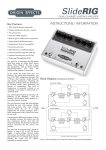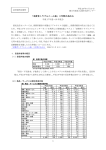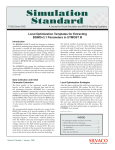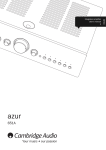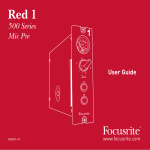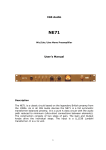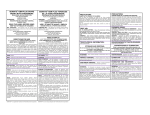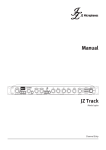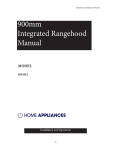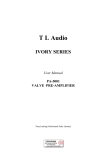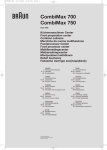Download TRANSFORMER-OPTION - USER INFORMATION
Transcript
"FET" BASED STUDIO-STYLE LIMITING AMPLIFIER TRANSFORMER-OPTION - USER INFORMATION Key Features: • 100% Class-A discrete output-amplifier • Custom-designed transformer driving a pair of outputs Figure 1: Transformer-Option Rear Panel (left to right): "INSTRUMENT" - input connection; "GND" - ground-lift switch; "LINE/DI" - balanced output; "PAD" pad/attenuation switch; "POWER" - power supply connection; "GAIN" - gain switch; "AMPLIFIER" - unbalanced output to drive instrument amplifier. • Unbalanced instrument-level output • Balanced line-level output • Ground-lift function to eliminate ground induced hum (balanced output only) • Signal-pad for DI (balanced output only) • Gain-switch adjusts level through transformer circuitry, for increased amplifier/transformer saturation • Auto-Shut-Down - effectively returns pedal to "stock" format when powered from a battery or low-voltage supply The Cali76 is a premium-quality, 1960sstyle FET compressor, inspired by the legendary Urei 1176. The transformer-option works in conjunction with the pedal to provide the user with additional tone-options and connectivity. A custom-designed transformer sits at the heart of the unit. The core-size and material have been selected to contribute harmonics when driven by the Class-A, transistorbased, output stage. Figure 2: Transformer-Option circuit boards. Board on left features standard "custom-designed" transformer. Board on right features high-linearity, broadspectrum Lundahl transformer. Installation At the time of publication, the transformer-option is only available to those customers purchasing a brand-new Cali76 pedal directly from Origin Effects. The option will be installed as part of the manufacturing process - carried out in the UK alongside the rest of our production. A retro-fit service may become available in the future, depending on demand. Power Requirements: Battery vs. Supply Operation The transformer-option requires a relatively large amount of supply-current in comparison to the "standard" Cali76. The extra current is put to use by the Class-A transistor output-stage, in order to drive problematic loads with ease (such as long cable runs as well as the low-impedance inputs of some vintage studio equipment). Just as importantly, the extra current-drive can be used to push the output-transformer into saturation. This generates frequency-dependant harmonics and subtle overdrive. Unfortunately, a standard 9V battery just couldn't supply this level of current for long enough to be practical, as the user would need to change batteries every few hours to maintain optimum results. For this reason we decided to opt for an automatic system that shuts-down the transformer board when a low-voltage supply is detected (this applies to external supplies as well as internal battery-usage). At low voltages, the signal is "diverted" around the transformer circuitry via a high-quality relay. The signal-path is therefore electronically-identical to the "standard" Cali76, and only the "INSTRUMENT" (input), "POWER" and "AMPLIFIER" (output) connections remain active. In this scenario, all rear-panel switches become inactive. When using an 18V supply the transformer circuitry springs to life, and the relay routes the signal through the transformer-board. We've designed the board around an 18V supply. Using a lower supply voltage may result in the pedal intermittently switching between transformer-enabled and transformerbypass modes. As always, higher supply voltages can cause damage to sensitive electronic components. Output Connections: Type and Suggested Usage The standard Cali76 features a single medium-impedance output. This can be used to connect the pedal to any highimpedance input, such as the input of a guitar/bass amplifier. In contrast, the transformer-enabled pedal offers two ultralow-impedance outputs, suitable for driving almost any audio input-connection! The "AMPLIFIER" output provides an unbalanced signal referenced to ground. This is ideal for connecting to your guitar/bass amplifier. The "LINE/DI" output provides a fully balanced signal via a TRS output socket, and can be used to connect to recording consoles, mixers, sound-cards, mic-preamplifiers etc... The "PAD" switch can be used to drop the signal by around 28dB, and this should give the user enough range to be able to plug into both line-level, and mic-level inputs. The "GND" switch (ground-lift) can be used to cure annoying hums and other ground-loop-related issues. Usefully, the "LINE/DI" output can be used to feed the input of a second guitar/bass amplifier by simply using a standard mono guitar lead. The ground-lift function is a must here as it will dispense with the ground-loop related hum normally generated when "Y-connecting" amplifier inputs (especially true when connecting the inputs of high-gain amplifiers). Headroom Adjustments: "GAIN" Switch Of all the functions, this one's most likely to cause confusion! This switch changes the gain of the output amplifier (i.e. the amplifier driving the primary of the output transformer). The "LOW" setting is the "stock/normal" setting. Using the "HIGH" setting boosts the internal gain by around 9dB. The "LOW" setting is clean and dynamic. However, when using the "HIGH" setting, you'll notice that the outputamplifier and transformer begin to run out of headroom. Overall the sound is richer in harmonics, becoming "edgy" sounding and ultimately clipping! The change in gain can be clearly heard when using the "LINE/DI" outputs. Using the "GAIN" switch will therefore require small level-adjustments to be made on any connected mixing consoles etc... In contrast, the "AMPLIFIER" output remains at a consistent level, due to a variable passive-attenuator network that perfectly counter-acts the level-shifting effects of the "GAIN" switch. This allows you to monitor the shifting tonal-effects through your guitar/bass rig, without having to tweak your amplifier's volume control. Bypass-Mode When actively engaged through the use of an 18V supply, the transformer-board effectively buffers the signal at all times, even when the unit is set to "Bypass". Please note that "True-Bypass" will only be operational when powering the unit from a battery or 9V external supply. This isn't really a negative point (as the Buffered-Bypass system is technically superior), but is certainly worthy of a mention. Further more, any saturation/overdrive experienced with the "GAIN" switch set in the "HIGH" position, may also be audible with the unit set to bypass - just like driving a Urei 1176 with the compression bypassed/defeated. If this proves to be a problem, you may want to consider purchasing an external bypass-looper in order to fully bypass the Cali76. Using an external bypass-looper would give you three useful pre-sets: dry signal; transformer-coloured dry signal; and lastly, compressed signal also with transformer colouration. About the Designer "Origin" products are currently being developed by Simon Keats, of UK-company, Keats Audio. Simon has worked for a number of big-name "audio" companies, on a full-time basis and as a design consultant. Simon can be reached by email, telephone or by post, and will be happy to help with any enquiries. Email: [email protected] Telephone: 0800 810 1070 International: +44 800 810 1070 Address: Simon Keats Origin Effects First Floor Office Unit C6 Station Yard Thame Oxfordshire OX9 3UH, UK Figure 3: "Standard" Cali76 PCB (with rear panel drilled for transformer-option). Simon Keats/Origin Effects is not affiliated with Urei or Universal Audio in any way. This product draws inspiration from the Urei "1176" compressor, but does not feature any "like-forlike" circuitry!!! Figure 4: Cali76 with "Transformer-Option" circuit board installed.



